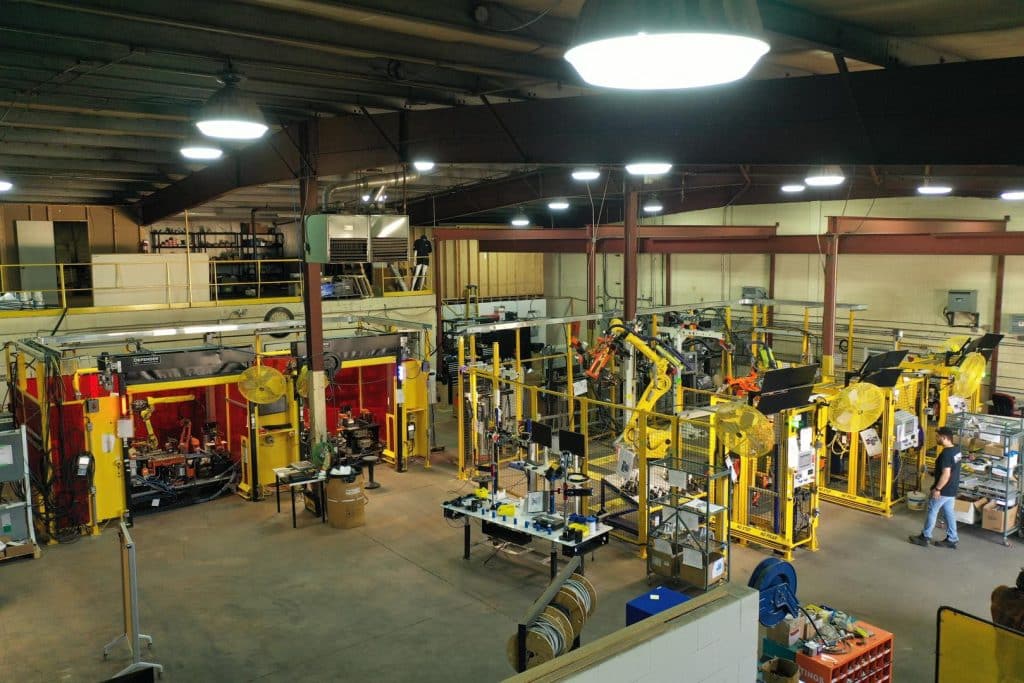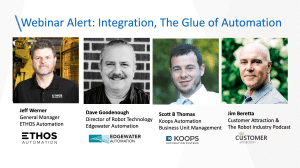Once you have decided to add robot automation to your manufacturing facility, the most important task you have is to choose a robot integrator. A robot integrator acts as a contractor of sorts, taking turnkey responsibility for every step of the robot automation integration process. They create and design the systems, including end effectors, sensors, parts feeders, conveyors, safety equipment, tooling and all kinds of supporting automation and third party equipment. Integrators also assume the risks to build and integrate disparate technologies into a working system, presenting the clients with a finished product to spec.
Integrators can significantly reduce time to market, have the required skill sets ready and available and keep costs and unexpected delays at a minimum. They liaise with suppliers and third-party vendors, arrange testing and training and often provide ongoing support, repairs and maintenance.
The earlier the integrator is involved in the project, the better the likelihood of success.
So how do you choose the robot integrator who is the best fit for your business? Read on.
Finding your robot integrator
Word of mouth is one of the best ways to create a list of possible integrators for your operation. Talk to colleagues in the industry who have integrated robotics, and ask for the name of their integrator.
- Establish weighting factors based on your industry, company and project. For example, if your industry has a number of compliance and safety requirements, you need to work with an integrator who plays in your space. Send out a Request for Proposal, and use the weighting factors to do a preliminary cut based on experience, expertise or cost estimate.
- Narrow your list to a top three or four. Start a more detailed evaluation. Ask for the project history in your space, their portfolio of completed installations, resumes of not just the executive team but also application engineers and the project team.
- Ask for references and call them.Visit non-competing completed installations 6 months or more after installation. Talk to the maintenance team, project manager, operators and management team. What was the communications approach like, how responsive was the integrator and what were the best and worst aspects of the integration project?
- Technical capability is essential. Ask for proof of certifications if they are needed, including ISO, FDA, EU, or welding. If there are specific certifications for your industry, ask about them. Are they authorized suppliers for vision systems, robots or end-of-arm-tools?
- Size matters. Big doesn’t mean they have unlimited capacity and big can mean overbooked. How many other projects do they have ongoing, where does your project rank in terms of size relative to others? If it’s a large build, can they meet your deadlines or will you be bumped to lower priority? If you are a new client to them, will they give you the same priority as their established clients?
- Check their financial position. Talk to their supply chain about their payment history and business relationships. Nothing can derail a build faster than a supplier refusing to ship because they haven’t been paid. What is their position in the industry? Are there any merger or acquisition talks you need to be aware of? Are they financially viable? Is your project their make or break, or is it bigger than anything they have handled previously?
Important to have
Innovation and flexibility
Many builds require flexibility or creative solutions. Some machinery builds will require designing in a different way. While not every build will need a completely custom solution, it’s good to have that expertise on hand.
Industry 4.0
The Industrial Internet of Things (IIoT) was already changing many business processes, and then the COVID-19 pandemic drove it into overdrive. An integrator familiar with robots, vision systems, edge computing, digital twin technology and IIoT can meet the demands of a changing manufacturing landscape. Smart technology is here to stay.
Corporate Culture
Robotic integration projects can have a very long timeline from concept to completion. While not essential, working with an integrator who has a similar corporate culture and work ethic makes the project run more smoothly. You can learn a lot about a company by how they treat their customer service or reception staff. Do employees tend to stay, or do they have a high turnover? You don’t want to lose a key project team member mid-way through the project.
The Fine Print
Once you have chosen your robot integrator, get the legal agreements completed immediately. Issues like patents, intellectual property and proprietary design can take weeks to iron out, and delay the start of the project. The fine print can often cause weeks of delay.
Request engineering studies on anything with a potential for high risk or complexity, such as complex welding, machine vision, tooling or precision dispense. Digital twin technology can identify and mitigate design issues before the actual build, saving time, materials and costly delays because no one noticed the beam on the wall by the installation site that is going to impede end effector movement, or make it impossible to reach the safety panel.
Partner for success
There are a few things the manufacturer can do to ensure the robot integration project goes smoothly.
- Be a good customer. Just as you want your integrator to be flexible and innovative, you also need to be willing to be flexible. If you have a reputation of being difficult to work with, requesting many design changes after sign-off, having unrealistic timelines or continuously requesting out of scope additions, many good integrators will not quote with you. And if there is an issue, it is best to approach from a collaborative standpoint.
- Have a detailed specification document. This will serve as the blueprint or roadmap, and the more more complete, the better. If you are unsure what should be included, hire outside expertise. More detail is always better.
- Complete preliminary engineering studies. If you have high risk or complex technology such as a complex weld, it can reduce time, cost and rework if you test proof of concept of a difficult component. An engineering study or a weld study can highlight risks, reduce price and increase time to market by solving some of the contentious issues upfront.
In many industries, automated robotic integrations are common, and many small and medium-sized businesses are now adding single-station and robotic standalone integrations.
Choosing the right integrator, and choosing early can set you up for success.
At Ethos Automation we are experts at complex robot integrated automation solutions, and we have expertise in welding automation, weld studies and tier 1 automotive. If you have a question, we are happy to have a conversation. info@ethosautomation.com or 888-384-6756



